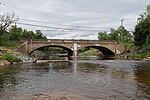United States Post Office–Hyattsville Main
Buildings and structures in Prince George's County, MarylandColonial Revival architecture in MarylandGovernment buildings completed in 1935Hyattsville, MarylandNational Register of Historic Places in Prince George's County, Maryland ... and 3 more
Post office buildings in MarylandPost office buildings on the National Register of Historic Places in MarylandPrince George's County, Maryland Registered Historic Place stubs

The Hyattsville Post Office is a one-story brick building constructed over a full basement, located on Gallatin Street in Hyattsville, Prince George's County, Maryland. The Colonial Revival building consists of a central, three-bay block flanked by smaller one-bay flat-roofed pavilions. It was constructed in 1935 and remains in active use. Murals by Eugene Kingman, depicting the agricultural heritage of Prince George's County, decorate the lobby. Its design reflects the attention Hyattsville resident and Fourth Assistant Postmaster General Smith W. Purdum paid to its construction.It was listed on the National Register of Historic Places in 1986.
Excerpt from the Wikipedia article United States Post Office–Hyattsville Main (License: CC BY-SA 3.0, Authors, Images).United States Post Office–Hyattsville Main
Gallatin Street, Hyattsville
Geographical coordinates (GPS) Address Nearby Places Show on map
Geographical coordinates (GPS)
| Latitude | Longitude |
|---|---|
| N 38.952777777778 ° | E -76.941388888889 ° |
Address
Gallatin Street
20781 Hyattsville
Maryland, United States
Open on Google Maps









